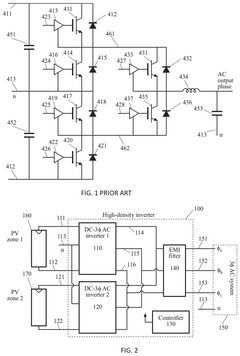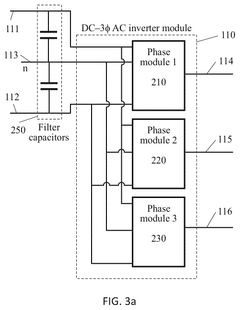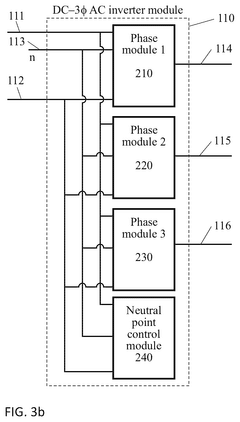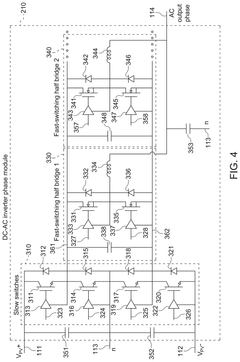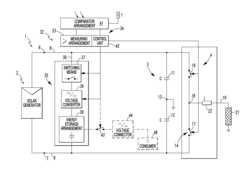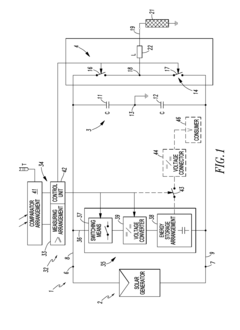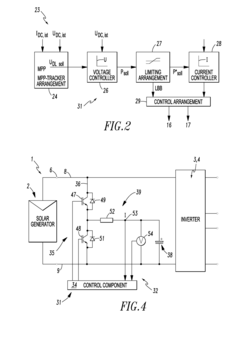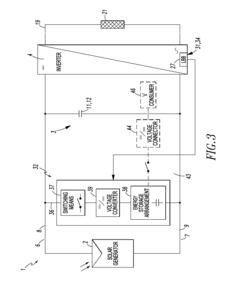Solar Inverter Efficiencies: Comparison Across Models
JUL 17, 20259 MIN READ
Generate Your Research Report Instantly with AI Agent
Patsnap Eureka helps you evaluate technical feasibility & market potential.
Solar Inverter Evolution
Solar inverter technology has undergone significant evolution since its inception in the 1990s. The early models were primarily designed for off-grid applications, with limited efficiency and power output. As solar energy adoption increased, inverters evolved to meet grid-connection requirements, leading to the development of string inverters in the early 2000s.
The mid-2000s saw a shift towards higher efficiency and reliability. Manufacturers focused on improving maximum power point tracking (MPPT) algorithms, which allowed inverters to extract more energy from solar panels under varying conditions. This period also marked the introduction of transformerless designs, reducing size and weight while increasing efficiency.
By the late 2000s, micro-inverters emerged as a solution for residential and small commercial installations. These devices, attached to individual solar panels, offered improved performance in partially shaded conditions and simplified system design. However, their higher cost per watt limited widespread adoption initially.
The 2010s brought significant advancements in power electronics and control systems. Wide-bandgap semiconductors, such as silicon carbide (SiC) and gallium nitride (GaN), began to replace traditional silicon in inverter designs. These materials allowed for higher switching frequencies, reduced losses, and improved thermal management, ultimately leading to higher efficiencies.
Smart features became increasingly prevalent during this period. Inverters integrated communication capabilities, allowing for remote monitoring, diagnostics, and grid interaction. This development paved the way for smart grid integration and improved overall system performance.
The latest generation of solar inverters, emerging in the late 2010s and early 2020s, focuses on maximizing energy yield and grid support functions. Advanced string inverters now incorporate multiple MPPTs, allowing for more flexible array configurations and improved performance under partial shading. Hybrid inverters, capable of managing both solar input and battery storage, have gained popularity as energy storage becomes more prevalent in residential and commercial systems.
Current trends in solar inverter evolution include further improvements in efficiency, with some models approaching 99% CEC efficiency. Size reduction continues to be a focus, with more compact and lightweight designs emerging. Additionally, enhanced grid support features, such as reactive power control and low voltage ride-through capabilities, are becoming standard as grid operators seek to integrate higher levels of distributed solar generation.
The mid-2000s saw a shift towards higher efficiency and reliability. Manufacturers focused on improving maximum power point tracking (MPPT) algorithms, which allowed inverters to extract more energy from solar panels under varying conditions. This period also marked the introduction of transformerless designs, reducing size and weight while increasing efficiency.
By the late 2000s, micro-inverters emerged as a solution for residential and small commercial installations. These devices, attached to individual solar panels, offered improved performance in partially shaded conditions and simplified system design. However, their higher cost per watt limited widespread adoption initially.
The 2010s brought significant advancements in power electronics and control systems. Wide-bandgap semiconductors, such as silicon carbide (SiC) and gallium nitride (GaN), began to replace traditional silicon in inverter designs. These materials allowed for higher switching frequencies, reduced losses, and improved thermal management, ultimately leading to higher efficiencies.
Smart features became increasingly prevalent during this period. Inverters integrated communication capabilities, allowing for remote monitoring, diagnostics, and grid interaction. This development paved the way for smart grid integration and improved overall system performance.
The latest generation of solar inverters, emerging in the late 2010s and early 2020s, focuses on maximizing energy yield and grid support functions. Advanced string inverters now incorporate multiple MPPTs, allowing for more flexible array configurations and improved performance under partial shading. Hybrid inverters, capable of managing both solar input and battery storage, have gained popularity as energy storage becomes more prevalent in residential and commercial systems.
Current trends in solar inverter evolution include further improvements in efficiency, with some models approaching 99% CEC efficiency. Size reduction continues to be a focus, with more compact and lightweight designs emerging. Additionally, enhanced grid support features, such as reactive power control and low voltage ride-through capabilities, are becoming standard as grid operators seek to integrate higher levels of distributed solar generation.
Market Demand Analysis
The market demand for solar inverters has been experiencing significant growth, driven by the increasing adoption of solar energy systems worldwide. As the critical component that converts direct current (DC) from solar panels into alternating current (AC) for use in homes and businesses, solar inverters play a crucial role in the efficiency and performance of photovoltaic systems.
The global solar inverter market is projected to expand at a compound annual growth rate (CAGR) of over 15% from 2021 to 2026. This growth is primarily attributed to the rising installation of solar power plants, government incentives for renewable energy adoption, and the decreasing costs of solar technology. Residential, commercial, and utility-scale solar installations are all contributing to this market expansion.
Efficiency has become a key differentiator in the solar inverter market. Higher efficiency inverters can extract more usable energy from solar panels, leading to improved system performance and faster return on investment for consumers. This has created a competitive landscape where manufacturers are constantly striving to improve their inverter efficiencies.
The market demand for high-efficiency solar inverters is particularly strong in regions with high electricity costs or limited roof space for solar installations. In these areas, maximizing energy output from available space is crucial, making highly efficient inverters more attractive. Countries like Germany, Japan, and parts of the United States have seen a surge in demand for premium, high-efficiency inverter models.
Another factor driving market demand is the increasing integration of smart features in solar inverters. Consumers are showing preference for inverters that offer advanced monitoring capabilities, grid support functions, and compatibility with energy storage systems. This trend is aligned with the broader movement towards smart homes and energy management systems.
The commercial and utility-scale segments are witnessing a shift towards string inverters and central inverters with higher power ratings. This is due to the growing size of solar installations and the need for more cost-effective solutions in large-scale projects. The demand for these higher capacity inverters is expected to grow significantly in the coming years.
Emerging markets, particularly in Asia-Pacific and Latin America, are showing strong potential for solar inverter demand. As these regions invest in expanding their renewable energy infrastructure, the need for efficient and reliable solar inverters is expected to rise substantially.
In conclusion, the market demand for solar inverters is robust and multifaceted, with efficiency being a key driver. The industry's focus on comparing and improving inverter efficiencies across different models is well-aligned with market needs and is likely to continue shaping product development and consumer choices in the solar energy sector.
The global solar inverter market is projected to expand at a compound annual growth rate (CAGR) of over 15% from 2021 to 2026. This growth is primarily attributed to the rising installation of solar power plants, government incentives for renewable energy adoption, and the decreasing costs of solar technology. Residential, commercial, and utility-scale solar installations are all contributing to this market expansion.
Efficiency has become a key differentiator in the solar inverter market. Higher efficiency inverters can extract more usable energy from solar panels, leading to improved system performance and faster return on investment for consumers. This has created a competitive landscape where manufacturers are constantly striving to improve their inverter efficiencies.
The market demand for high-efficiency solar inverters is particularly strong in regions with high electricity costs or limited roof space for solar installations. In these areas, maximizing energy output from available space is crucial, making highly efficient inverters more attractive. Countries like Germany, Japan, and parts of the United States have seen a surge in demand for premium, high-efficiency inverter models.
Another factor driving market demand is the increasing integration of smart features in solar inverters. Consumers are showing preference for inverters that offer advanced monitoring capabilities, grid support functions, and compatibility with energy storage systems. This trend is aligned with the broader movement towards smart homes and energy management systems.
The commercial and utility-scale segments are witnessing a shift towards string inverters and central inverters with higher power ratings. This is due to the growing size of solar installations and the need for more cost-effective solutions in large-scale projects. The demand for these higher capacity inverters is expected to grow significantly in the coming years.
Emerging markets, particularly in Asia-Pacific and Latin America, are showing strong potential for solar inverter demand. As these regions invest in expanding their renewable energy infrastructure, the need for efficient and reliable solar inverters is expected to rise substantially.
In conclusion, the market demand for solar inverters is robust and multifaceted, with efficiency being a key driver. The industry's focus on comparing and improving inverter efficiencies across different models is well-aligned with market needs and is likely to continue shaping product development and consumer choices in the solar energy sector.
Efficiency Challenges
Solar inverter efficiency remains a critical challenge in the photovoltaic industry, with significant implications for overall system performance and cost-effectiveness. Despite advancements in technology, inverters continue to be a primary source of energy loss in solar power systems. The main efficiency challenges stem from various factors, including power conversion losses, thermal management issues, and the need for improved maximum power point tracking (MPPT) algorithms.
Power conversion losses occur during the DC to AC conversion process, where a portion of the energy is dissipated as heat. These losses are influenced by the quality of components used, such as semiconductors and capacitors, as well as the inverter's topology and switching frequency. High-frequency switching can reduce the size of passive components but may increase switching losses, creating a trade-off that designers must carefully balance.
Thermal management presents another significant challenge. As inverters process large amounts of power, they generate substantial heat. Ineffective heat dissipation can lead to reduced efficiency and shortened component lifespan. Innovative cooling solutions, such as advanced heat sink designs and active cooling systems, are being explored to address this issue. However, these solutions often add complexity and cost to the inverter design.
MPPT algorithms play a crucial role in maximizing energy harvest under varying environmental conditions. While current MPPT techniques are relatively advanced, there is still room for improvement, especially in handling partial shading scenarios and rapid changes in irradiance. Developing more sophisticated and responsive MPPT algorithms remains an ongoing challenge for inverter manufacturers.
The efficiency gap between different inverter models and technologies is another area of concern. While some high-end inverters boast efficiencies above 98%, many models still operate at lower efficiencies, particularly in the residential and small commercial segments. This disparity highlights the need for continued innovation and cost reduction in high-efficiency inverter technologies.
Grid integration challenges also impact inverter efficiency. As grid codes become more stringent, inverters must provide advanced grid support functions, such as reactive power control and low voltage ride-through capabilities. Implementing these features without significantly compromising efficiency is a complex task that requires careful design considerations.
Lastly, the push for higher power density in inverters, driven by the desire for more compact and lightweight systems, introduces additional efficiency challenges. Balancing the need for smaller form factors with optimal thermal management and high efficiency is an ongoing area of research and development in the solar inverter industry.
Power conversion losses occur during the DC to AC conversion process, where a portion of the energy is dissipated as heat. These losses are influenced by the quality of components used, such as semiconductors and capacitors, as well as the inverter's topology and switching frequency. High-frequency switching can reduce the size of passive components but may increase switching losses, creating a trade-off that designers must carefully balance.
Thermal management presents another significant challenge. As inverters process large amounts of power, they generate substantial heat. Ineffective heat dissipation can lead to reduced efficiency and shortened component lifespan. Innovative cooling solutions, such as advanced heat sink designs and active cooling systems, are being explored to address this issue. However, these solutions often add complexity and cost to the inverter design.
MPPT algorithms play a crucial role in maximizing energy harvest under varying environmental conditions. While current MPPT techniques are relatively advanced, there is still room for improvement, especially in handling partial shading scenarios and rapid changes in irradiance. Developing more sophisticated and responsive MPPT algorithms remains an ongoing challenge for inverter manufacturers.
The efficiency gap between different inverter models and technologies is another area of concern. While some high-end inverters boast efficiencies above 98%, many models still operate at lower efficiencies, particularly in the residential and small commercial segments. This disparity highlights the need for continued innovation and cost reduction in high-efficiency inverter technologies.
Grid integration challenges also impact inverter efficiency. As grid codes become more stringent, inverters must provide advanced grid support functions, such as reactive power control and low voltage ride-through capabilities. Implementing these features without significantly compromising efficiency is a complex task that requires careful design considerations.
Lastly, the push for higher power density in inverters, driven by the desire for more compact and lightweight systems, introduces additional efficiency challenges. Balancing the need for smaller form factors with optimal thermal management and high efficiency is an ongoing area of research and development in the solar inverter industry.
Current Efficiency Solutions
01 Advanced control strategies for solar inverters
Implementing sophisticated control algorithms and strategies to optimize the operation of solar inverters, improving their overall efficiency and performance. These strategies may include maximum power point tracking (MPPT), grid synchronization techniques, and adaptive control methods to handle varying environmental conditions and load demands.- Advanced control strategies for solar inverters: Implementing sophisticated control algorithms and strategies to optimize the operation of solar inverters, improving their overall efficiency and performance. These strategies may include maximum power point tracking (MPPT), grid synchronization techniques, and intelligent power management systems.
- Improved power conversion topologies: Developing and implementing novel power conversion topologies and circuit designs to enhance the efficiency of solar inverters. This may include multi-level inverter architectures, soft-switching techniques, and advanced semiconductor devices to reduce switching losses and improve power quality.
- Thermal management and cooling solutions: Incorporating effective thermal management techniques and cooling solutions to maintain optimal operating temperatures for solar inverters. This can include advanced heat sink designs, liquid cooling systems, or phase-change materials to dissipate heat and improve overall efficiency.
- Integration of energy storage systems: Combining solar inverters with energy storage systems, such as batteries, to enhance overall system efficiency and reliability. This integration allows for better management of power flow, improved grid stability, and increased self-consumption of solar energy.
- Smart grid connectivity and communication: Enhancing solar inverter efficiency through improved connectivity and communication with smart grid systems. This includes features such as real-time monitoring, remote diagnostics, and adaptive control algorithms that optimize inverter performance based on grid conditions and energy demand.
02 Improved power conversion topologies
Developing and implementing novel power conversion topologies and circuit designs to enhance the efficiency of solar inverters. This may involve the use of advanced semiconductor devices, multi-level inverter configurations, or resonant converter designs to reduce switching losses and improve power quality.Expand Specific Solutions03 Thermal management and cooling solutions
Incorporating effective thermal management techniques and cooling solutions to maintain optimal operating temperatures for solar inverter components. This can include advanced heat sink designs, liquid cooling systems, or phase-change materials to dissipate heat efficiently and prevent performance degradation due to thermal stress.Expand Specific Solutions04 Integration of energy storage systems
Combining solar inverters with energy storage systems, such as batteries or supercapacitors, to improve overall system efficiency and reliability. This integration allows for better management of power fluctuations, grid support functions, and increased self-consumption of generated solar energy.Expand Specific Solutions05 Smart grid connectivity and communication
Enhancing solar inverter efficiency through improved connectivity and communication with smart grid systems. This includes implementing advanced monitoring and control features, remote diagnostics, and adaptive grid support functions to optimize power flow and system performance in real-time.Expand Specific Solutions
Key Industry Players
The solar inverter efficiency market is in a mature growth phase, characterized by intense competition among established players and ongoing technological advancements. The global market size is projected to reach significant figures, driven by increasing solar energy adoption worldwide. Technologically, the field is rapidly evolving, with companies like Enphase Energy, SMA Solar Technology, and Huawei Digital Power leading innovations in microinverters and string inverters. These firms, along with others such as Delta Electronics and ABB Group, are pushing the boundaries of efficiency, reliability, and smart grid integration. The competitive landscape is further shaped by regional players and new entrants, fostering a dynamic environment of continuous improvement and market expansion.
Enphase Energy, Inc.
Technical Solution: Enphase Energy specializes in microinverter technology for solar systems. Their IQ8 microinverters achieve up to 97.7% CEC efficiency[1]. The microinverter design allows for module-level power conversion, enhancing system reliability and performance. Enphase's technology includes advanced grid-forming capabilities, enabling solar systems to form microgrids during power outages. Their Ensemble energy management system integrates solar, storage, and load control for comprehensive energy solutions[2].
Strengths: High efficiency, module-level optimization, and advanced grid-forming capabilities. Weaknesses: Higher initial cost compared to string inverters, and potential for more points of failure due to multiple inverters.
SMA Solar Technology AG
Technical Solution: SMA Solar Technology offers a range of inverter solutions, including string inverters, central inverters, and battery inverters. Their Sunny Tripower CORE1 commercial inverter achieves up to 98.1% efficiency[3]. SMA's inverters incorporate advanced grid management functions and are compatible with their SMA Smart Connected service for remote monitoring and diagnostics. The company also focuses on developing hybrid inverters that integrate solar and storage systems, such as the Sunny Boy Storage series, which offers efficiencies up to 97.5%[4].
Strengths: Wide product range, high efficiency, and advanced grid management features. Weaknesses: Some models may have lower efficiency compared to competitors in specific power ranges.
Innovative Designs
High density interleaved inverter
PatentActiveUS12132387B2
Innovation
- The use of wide bandgap materials like SiC MOSFETs and innovative circuit designs that allow operation at higher switching frequencies, such as 100 kHz or above, with phase-shifted pulse-width modulation to reduce EMI and minimize the size of filter components, enabling increased power density and automated manufacturing.
Solar inverter for an extended insolation range and operating method
PatentInactiveUS9118212B2
Innovation
- An inverter system with an additional energy storage device and control arrangement that detects insolation peaks, buffering excess energy for later use, allowing the solar generator to operate at its maximum power point without changing the operating point, even with a limited-capacity inverter.
Grid Integration Impact
The integration of solar inverters into the electrical grid has significant implications for overall system stability, power quality, and grid management. As solar inverter efficiencies continue to improve across different models, their impact on grid integration becomes increasingly important. Higher efficiency inverters contribute to reduced energy losses and improved power output, which can lead to more stable and reliable grid operations.
One of the primary considerations in grid integration is the ability of solar inverters to provide grid support functions. Advanced inverters with higher efficiencies are often equipped with features such as reactive power control, voltage regulation, and frequency response. These capabilities allow the inverters to actively participate in maintaining grid stability, particularly in areas with high penetration of solar power.
The harmonics introduced by solar inverters can affect power quality on the grid. More efficient inverters typically produce lower levels of harmonic distortion, which reduces the need for additional filtering equipment and minimizes potential interference with other grid-connected devices. This improved power quality contributes to the overall health and longevity of the electrical infrastructure.
As inverter efficiencies increase, the potential for higher power densities in solar installations also rises. This can lead to more compact and cost-effective solar power plants, potentially accelerating the deployment of solar energy on a larger scale. However, it also presents challenges for grid operators in terms of managing sudden changes in power output due to weather conditions or other factors.
The impact of higher efficiency inverters on grid integration extends to the realm of energy storage as well. When coupled with battery systems, these inverters can provide enhanced grid services, such as peak shaving and load shifting. This integration of solar and storage technologies, facilitated by efficient inverters, can significantly improve the flexibility and resilience of the electrical grid.
From a utility perspective, the increased efficiency of solar inverters across models can lead to more predictable and manageable power generation profiles. This predictability aids in grid planning and operation, potentially reducing the need for costly grid reinforcements and improving overall system reliability. However, it also necessitates the development of more sophisticated grid management systems capable of handling the dynamic nature of distributed solar generation.
In conclusion, the comparison of solar inverter efficiencies across models has far-reaching implications for grid integration. As efficiencies continue to improve, the potential for enhanced grid stability, power quality, and system flexibility increases. However, these advancements also require ongoing adaptation of grid infrastructure and management practices to fully leverage the benefits of high-efficiency solar inverters in the evolving landscape of renewable energy integration.
One of the primary considerations in grid integration is the ability of solar inverters to provide grid support functions. Advanced inverters with higher efficiencies are often equipped with features such as reactive power control, voltage regulation, and frequency response. These capabilities allow the inverters to actively participate in maintaining grid stability, particularly in areas with high penetration of solar power.
The harmonics introduced by solar inverters can affect power quality on the grid. More efficient inverters typically produce lower levels of harmonic distortion, which reduces the need for additional filtering equipment and minimizes potential interference with other grid-connected devices. This improved power quality contributes to the overall health and longevity of the electrical infrastructure.
As inverter efficiencies increase, the potential for higher power densities in solar installations also rises. This can lead to more compact and cost-effective solar power plants, potentially accelerating the deployment of solar energy on a larger scale. However, it also presents challenges for grid operators in terms of managing sudden changes in power output due to weather conditions or other factors.
The impact of higher efficiency inverters on grid integration extends to the realm of energy storage as well. When coupled with battery systems, these inverters can provide enhanced grid services, such as peak shaving and load shifting. This integration of solar and storage technologies, facilitated by efficient inverters, can significantly improve the flexibility and resilience of the electrical grid.
From a utility perspective, the increased efficiency of solar inverters across models can lead to more predictable and manageable power generation profiles. This predictability aids in grid planning and operation, potentially reducing the need for costly grid reinforcements and improving overall system reliability. However, it also necessitates the development of more sophisticated grid management systems capable of handling the dynamic nature of distributed solar generation.
In conclusion, the comparison of solar inverter efficiencies across models has far-reaching implications for grid integration. As efficiencies continue to improve, the potential for enhanced grid stability, power quality, and system flexibility increases. However, these advancements also require ongoing adaptation of grid infrastructure and management practices to fully leverage the benefits of high-efficiency solar inverters in the evolving landscape of renewable energy integration.
Cost-Efficiency Tradeoffs
When evaluating solar inverter models, a critical consideration is the balance between cost and efficiency. Higher efficiency inverters typically come with a premium price tag, while more affordable options may sacrifice some performance. This tradeoff necessitates a careful analysis to determine the optimal solution for specific solar energy projects.
Efficiency ratings for solar inverters generally range from 95% to 99%, with the most advanced models pushing the upper limits. However, the incremental gains in efficiency at the higher end often come with disproportionate increases in cost. For instance, a 98% efficient inverter may cost significantly more than a 97% efficient model, despite offering only a marginal improvement in energy conversion.
The impact of inverter efficiency on overall system performance is substantial. Even a small increase in efficiency can translate to significant energy savings over the lifetime of a solar installation. For large-scale projects, these savings can offset the higher initial investment in more efficient inverters. Conversely, for smaller residential systems, the payback period for premium inverters may extend beyond practical limits.
Manufacturing processes and component quality play a crucial role in determining both the cost and efficiency of solar inverters. Advanced semiconductor materials and sophisticated control algorithms contribute to higher efficiencies but also drive up production costs. Mass production and economies of scale can help mitigate some of these expenses, but cutting-edge technologies often remain at a price premium.
Durability and lifespan are additional factors that influence the cost-efficiency equation. More expensive inverters often feature higher-quality components and better thermal management, potentially leading to longer operational lives and reduced maintenance costs. This longevity can offset the initial price difference over time, especially in harsh environmental conditions or high-usage scenarios.
Market dynamics also play a role in shaping the cost-efficiency landscape. As competition intensifies and technologies mature, the price gap between high-efficiency and standard models tends to narrow. This trend makes higher-efficiency inverters increasingly accessible, potentially shifting the balance in favor of more advanced solutions.
Ultimately, the decision between cost and efficiency depends on various project-specific factors, including system size, location, energy prices, and available incentives. A comprehensive lifecycle cost analysis, factoring in initial investment, energy yields, and long-term operational expenses, is essential for making informed choices in solar inverter selection.
Efficiency ratings for solar inverters generally range from 95% to 99%, with the most advanced models pushing the upper limits. However, the incremental gains in efficiency at the higher end often come with disproportionate increases in cost. For instance, a 98% efficient inverter may cost significantly more than a 97% efficient model, despite offering only a marginal improvement in energy conversion.
The impact of inverter efficiency on overall system performance is substantial. Even a small increase in efficiency can translate to significant energy savings over the lifetime of a solar installation. For large-scale projects, these savings can offset the higher initial investment in more efficient inverters. Conversely, for smaller residential systems, the payback period for premium inverters may extend beyond practical limits.
Manufacturing processes and component quality play a crucial role in determining both the cost and efficiency of solar inverters. Advanced semiconductor materials and sophisticated control algorithms contribute to higher efficiencies but also drive up production costs. Mass production and economies of scale can help mitigate some of these expenses, but cutting-edge technologies often remain at a price premium.
Durability and lifespan are additional factors that influence the cost-efficiency equation. More expensive inverters often feature higher-quality components and better thermal management, potentially leading to longer operational lives and reduced maintenance costs. This longevity can offset the initial price difference over time, especially in harsh environmental conditions or high-usage scenarios.
Market dynamics also play a role in shaping the cost-efficiency landscape. As competition intensifies and technologies mature, the price gap between high-efficiency and standard models tends to narrow. This trend makes higher-efficiency inverters increasingly accessible, potentially shifting the balance in favor of more advanced solutions.
Ultimately, the decision between cost and efficiency depends on various project-specific factors, including system size, location, energy prices, and available incentives. A comprehensive lifecycle cost analysis, factoring in initial investment, energy yields, and long-term operational expenses, is essential for making informed choices in solar inverter selection.
Unlock deeper insights with Patsnap Eureka Quick Research — get a full tech report to explore trends and direct your research. Try now!
Generate Your Research Report Instantly with AI Agent
Supercharge your innovation with Patsnap Eureka AI Agent Platform!
